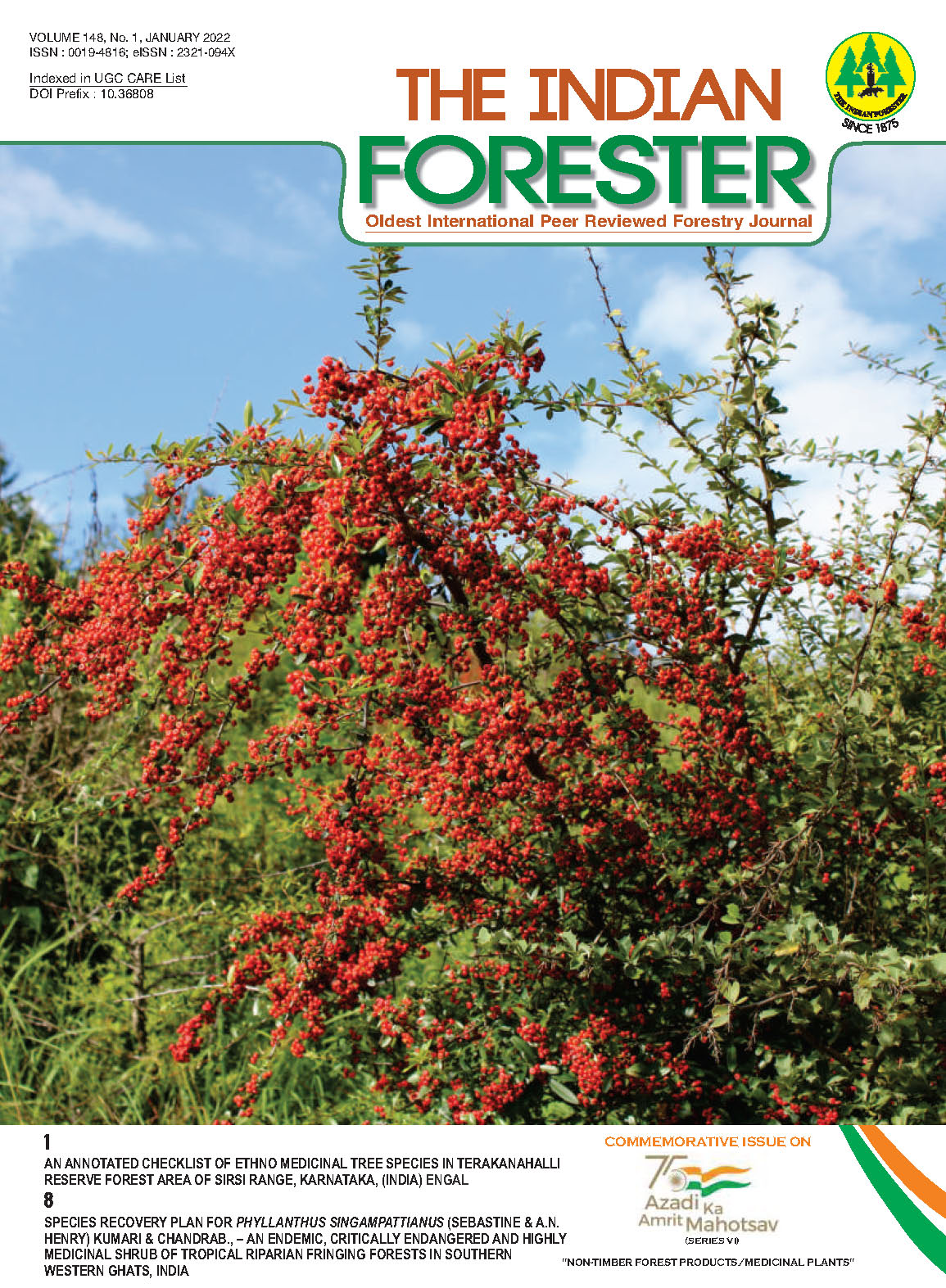Distribution and Ecological Status of Ashtavarga Group of Plants in Shimla District of Himachal Pradesh, North Western Himalaya
DOI:
https://doi.org/10.36808/if/2022/v148i1/158483Keywords:
Ashtavarga, Temperate Forest, Niches, Threatened, Conservation, Himalaya,Abstract
India's ethno medicinal heritage is like old gold, which has been augmented by the early Ayurvedic wonder healers. Numerous plants and plant groups like Dashamool and Ashtavarga, have mention in the ancient scriptures and the compendiums of the once famous Indian traditional medicine, like the Charaka Samhita and Susruta Samhita. All the plants belonging to the Ashtavarga group have their natural habitats in the temperate forests of Himachal Pradesh. Moreover, the district of Shimla has exacting niches for each one of them. Their importance has resulted in over-exploitation in the past and as a consequence all of them are threatened and are fighting a losing battle for survival. This study aims at identification, distribution and status of the Ashtavarga group of medicinal plants. The declining and threatened population of this group of plants is resulting in substitution and adulteration with other plants. The valuable information obtained during this study will be helpful for immediate action and effective conservation efforts required in future.References
Benson L. (1962). Plant Taxonomy: Methods and Principles. The Ronald Press Company, New York. Conservation Assessment and Management Prioritization (CAMP). (2010).
Chauhan R.S, Nautiyal M.C., Prasad P and Purohit H. (2008). Ecological features of an endangered medicinal orchid, Malaxis muscifera (Lindley) Kuntze, in the western Himalaya. MIOS Journal, 9(6):8-12.
Collett H. (1902). Flora Simlensis: A Handbook of the Flowering Plants of Simla and the Neighbourhood. Thacker Spink and Co., Calcutta. 652 pp.
Deva S. and Naithani H.B. (1986). The Orchid flora of North West Himalayas, New Delhi.
Dhyani A. (2009). Lilium polyphyllum - rarest of rare lilies. In Lilies and related plants, 85-91.London, England: Royal Horticulture Society.
Frawley David (2012). Soma in Yoga and Ayurveda - The Power of Rejuvenation and Immortality. Lotus Press. 392 pp.
Goraya G.S., Jishtu V., Rawat G.S. and Ved D.K. (2013). Wild medicinal plants of Himachal Pradesh: An assessment for their conservation status and management prioritization. Himachal Pradesh Forest Department, Shimla, Himachal Pradesh, India.
IUCN. (2003). Guidelines for Application of IUCN Red List Criteria at Regional Levels: Version 3.0. IUCN Species Survival Commission. IUCN, Gland, Switzerland and Cambridge, UK.
Jain S.K. and Rao R.R. (1993). Handbook of Field and Herbarium Methods. Today & Tomorrow's Printers and Publishers.
Joshi V.K. (1983). Evolution of the concept of Astavarga. Indian J. Hist. Sci., 18(1): 9-1.
MEA. (2005). Ecosystems and Human Well-Being: Synthesis. Island Press, Washington, DC.
Mora C., Tittensor D.P., Adl S., Simpson A.G.B. and Worm B. (2011). How many species are there on earth and in the ocean? PLoS Biology, 9:1100-1127.
Novasek M.J. and Cleland E. E. (2001). The current biodiversity extinction event: Scenarios for mitigation and recovery. Science, 98(10): 5466 - 5470.
Sahu R., Prakash I., Mishra R., Maliye A. and Sonekar M. (2016). Phytochemical Screening and HPTLC Finger Printing Analysis of Roscoea procera (Kakoli) and Lilium polyphyllum (Kshirkakoli). IJPPR, 8(1): 53-69.
Samant S.S., Dhar U. and Rawal R.S. (1996). Conservation of rare endangered plants: The context of Nanda Devi Biosphere Reserve. In: Conservation and management of biological resources in Himalaya.
Samant S.S., Dhar U. and Palni L.M.S. (1998). Medicinal Plants of Indian Himalaya: Diversity Distribution Potential Values. Nainital: Gyanodaya Prakashan
Sharma Pankaj, S.S. Samant and Manohar Lal (2017). Assessment of plant diversity for threat elements: A case study of Nargu wildlife sanctuary, north western Himalaya. Ceylon Journal of Science, 46(1) 2017: 75-95.
Sharma A., Rao C.H., Tiwari R.K., Tyagi L.K., Kori M.L. and Shankar K. (2009). Comparative Studies on Physiochemical variation of Microstylis wallichii. A drug used in Ayurveda. Academic Journal of Plant Science. 2(1):4-8.
Sharma B.D. and Balkrishna A.V. (2005). Vitality strengthening Astavarga plants (Jeevaniya and Vayasthapan Paudhe), Uttaranchal, India: Divya Publishers, Divya Yog Mandir.
Sharma P., Mahajan N., Garg P., Singh G., Dadhwal S. and Sharma S. (2011). Malaxis acuminata: A Review. IJRAP, 2(2): 422 - 425.
Sheldon J.M., Balick M. and Laird S. (1998). Is using medicinal plants compatible with conservation? Plant Talk April, 29-31.
Singh N., Singh A.K., Nilofer Absar V.R.S. and Singh P. (2018). Importance of endangered/rare, Astavarga medicinal plants in traditional system of medicine in Ayurveda. International Journal of Agricultural Sciences, 14(1): 258-265.
Tali B.A., Ganie A.H., Nawchoo I. A., Wani A. A. and Reshi Z.A. (2015). Assessment of threat status of selected endemic medicinal plants using IUCN regional guidelines: A case study from Kashmir Himalaya. Journal of Nature Conservation, 23: 80-89.
Tewari V.P., K.C. Tewari and B.B.L. Yadava (1976). Study of Roscoeaprocera Wall. (Kakoli-Ksheerkakoli of Astavarga). Quarterly Journal of Crude Drug Research, 14, ISS. 2.
Ved D.K., Kinhal G.K., Ravikumar K., Prabhakaran V., Ghate U., Sankar R.V. and Indresha J.H. (Eds.). (2003). Conservation and Assessment Management Prioritization for the Medicinal Plants of Jammu and Kashmir, Himachal Pradesh and Uttaranchal. FRLHT, Bangalore. 206 pp.
Vij S.P., Verma J. and Sathish C. Kumar (2013). Orchids of Himachal Pradesh. Bishen Singh Mahendra Pal Singh, ehradun, India.
Virk J.K., Bansal P., Gupta V., Kumar S. and Singh R. (2015). Lack of pharmacological basis of substitution of an endangered plant group Ashtawarga - A significant ingredient of polyherbal formulations. Am J Phytomed Clin. Ther. 2: 690-712.
Virk J.K., Gupta V., Kumar S., Singh R. and Bansal P. (2017). Ashtawarga plants-Suffering a triple standardization syndrome. Journal of Traditional and Complementary Medicine, 7.
Downloads
Downloads
Additional Files
Published
How to Cite
Issue
Section
License
Unless otherwise stated, copyright or similar rights in all materials presented on the site, including graphical images, are owned by Indian Forester.





